Casio SA-9, SA-20 |
mini keyboard with complex lo-fi wavetable sounds |
|
The Casio SA-series ToneBank keyboards were the first cheap sound bank instruments with up to 100 PCM preset sounds based on samples using a single-chip CPU. They were initially released as competitor to the Yamaha VoiceBank FM instruments those also had up to 100 preset sounds. The variety of cold echoey synth timbres full of reverb have a typical late 1980th new wave appeal. The SA-series was the first complex softsynth on a chip.
The SA-1 was a technical milestone in the way how low-end mini keyboards were built and what they could do. While the construction was reduced to a minimum count of parts, the polyphonic synth sound with surprisingly complex behaving algorithmic envelopes and modulations is still impressive. It has rhythms made with many kinds of sampled percussion, fixed-key accompaniments, keysplit presets and keyboard drumkit modes. But the SA-series also first time formed a strict separation as a beginners keyboard from more professional instruments, because all buttons sound a (typewriter) click noise that disturbs life performance.
This instrument was also released as Realistic Concertmate-360 and later re-released with different demo as Casio SA-7 (white with blue control panel) and SA-9 (in red or in black with blue panel).

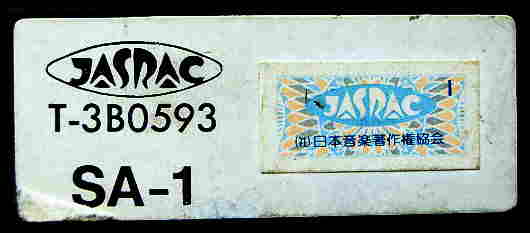 |
This odd sticker says: "SA-1, JASRAC T-3B0593" and has some Japanese characters. Someone wrote me that JASRAC is the Japanese music authors copyright organization, similar like the German GEMA. Most later sample based Casio keyboards (since Casio MT-540) have such a sticker. Apparently this only refers to included demo songs when they are no traditionals. I first thought that also accompaniments or even the samples itself had been registered there, but older Casio keyboards with only few (like SK-1) or no samples have none, independent from their accompaniment complexity. |
The "piano" is well recognizable (only more "perfect" and cleaner than a genuine acoustic piano) and the "honky- tonk piano" too. The "elec piano" sounds metallic like a rod based high grade clock chime or toy piano. The "harpsichord" is even very metallic and the envelope gets shorter(!) with held keys. The "jazz organ" and especially the "elec organ" have a unique tinny and squawky digital timbre. Although it was likely designed to imitate a Hammond organ tone, the timbre is different and rather somewhat reminds to an "ah"- voice through a telephone or a cup- muted trumpet or the like. The "pipe organ" is a metal pipe organ rank while "church organ" sounds more like a wooden pipe rank. The "brass ens" is a tinny, brassy and dry toot with chorus but no reverb. It resembles rather a car horn or pneumatic fanfare and sounds incredible artificial and static. The "warm brass" (with reverb) sounds more natural. The "tuba" has chorus but no reverb and rather resembles a dull distorted e-guitar. The "trumpet" is way too harsh. The "brass hit" is a percussive short brass note with reverb and 2 echoes after key release. The "wind ens" is rather natural. The "english horn" sounds hollow and more like an oboe (no reverb) while the oboe is brassy (with reverb). The "bassoon" and "clarinet" are ok (no reverb), the latter with delayed vibrato. The "samba whistle" plays only 2 different pitches. The "whistle" sounds nice, "quena" and "flute also (slow vibrato). The "flute- vib" starts percussive like a vibraphone. The "ocarina" has a percussive attack phase (delayed vibrato). The "bagpipe" quickly howls up to the played note (woodwind timbre). "harmonica" is a harsh tone that resembles more a trumpet ensemble or fanfare. The "chorus" is rather a silent fading high flute with vibrato. "brass- strings" resembles "brass ens", but with echo after key release. "strings" and "warm strings" are a bit harsh. The "violin" sounds more like a saxophone with delayed vibrato and reverb (Casio VL-Tone did it better). The "cello" is similar and rather a harsh tuba or bass saxophone. The "elec guitar" is more a koto or picked violin or harp. The "jazz guitar" may be a nylon one and the "mute guitar" blips short with the same timbre (intensified by the reverb). The "metal guitar" shall be a distorted one but resembles a very harsh and distorted church organ or the like. The "metal lead" is similar but less harsh and with delayed vibrato. The "snare bass" is a layered snare and e-bass sample, which sounds grainy in the bass range and may be nice for tekkno. The "ukulele" is harsh with an echo during key release. The "banjo" has reverb except with held keys. The "sitar" is a harsh sound with chorus (fairly realistic). The "mandolin" rings. The "harp" blips short and has 3 slow echoes after key release. The "taishokoto" quickly rings during attack phase and has reverb except with held keys. The "shamisen" sounds like a short, distorted e-guitar without reverb. The "synth- celesta" is rather a harsh picked string with chorus and an echo during fast key release. "synth- clavi" has no reverb. "synth- accordion" is a harsh tone with chorus. "synth- brass" is a lower variant of it. "synth- reed" is a squarewave lead synth with vibrato (chorus?, speed varies with note pitch). "synth- lead" is a harsh timbre with delayed vibrato, which reminds to Rob Hubbard's C64 lead synth timbres. The "pop lead" is a harsher and more massive variant of it and sounds like exactly copied from the "magical wind" sound on Casio CZ-230S. The "synth- strings" resembles a cello ensemble. "synth- guitar" is a harsh short e-guitar. "synth- bass" sounds like a slap bass. "glass harmonica" is a bowed glass. The "fantasy" sound has nothing to do with the famous Casio VL-Tone timbre but is a strange howling harsh brass chorus timbre that resembles much a sitar. The "wah voice" is a male chorus which howls up during attack phase and has a nice bass range. The "twinkle echo" is a harp with 3 echoes after key release (and reverb). "cathedral" is a disharmonic mixture (major chord?) of church organ and 3 church bell clangs after key release (long sustain). "cosmic dance" is another characteristic timbre; its a disharmonic strum of 3 muffled picked strings those simultaneously sound again during key release (going "drripp... bimm", on a major chord?). The "plunk extend" is a buzzy bubbling sort of synth e-bass which bass range reminds to a buzzing ruler. The "pearl drop" is a water droplet with melodic echo during fast key release. There are also 4 key split combinations: "bass/ piano", "bass/ trumpet", "piano/ flute", strings/ oboe".
The "airplane" is a buzzing propeller plane with rising pitch (key pitches are assigned narrower than normal notes). "ambulance" toggles between 2 notes (narrow key pitches, long sustain). "insect" chirps like locusts (only 2 pitches). "emergency alarm" is a fast siren in the right and slowly rising buzzing tone (like motor bike) in the left keyboard half. "laser beam" are 2 siren- like buzzing space sci-fi tekkno effects: the first howls 2 times and goes up while it fades silent, the 2nd toots high and then goes down like a siren and stays at a low tone while it is rhythmically chopped. "cosmic sound" is a slowly down and up fading, harsh and thin purring chirping (both only 1 pitch). The "telephone" plays to the right a phone touch tone and to the left a phone toot (both melodic playable). "car horn" sounds like expected (but only 2 pitches). The "computer sound" is a melodic pattern like a siren- like glissando that plays on "c" e.g. "c" followed by "g, f, g, f..." on a xylophone- like timbre, which note sequence continues in the reverb. "typewriter" is a sample of a mechanical typewriter. The "marimba" rings fast. The "church bells" clang disharmonic with 3 slow echoes. The "bells" timbre resemble more ceramic bowls or a toy piano. The "gamelan" sounds a bit disharmonic (like intended?, using a special tone scale?). "afro percussion" resemble a marimba - unfortunately only 2 pitches.
"ethnic percussion" rings buzzy and grainy like an old alarm clock. The "sample percussion" is a gong or cymbal which pitch ascends during the attack phase (sounds like from a Peking opera). The "matsuri" sounds like hammering nails into a wood box full of bottles or the like (only 2 pitches). The "wadaiko" is a wood drum (only 4 pitches). The "triangle" has only 1 pitch (but short and long version). "conga/ agogo" is a percussion kit sounding like 2 wood drums and 2 pinball bells (cowbells?). "cowbell/ clave" is a kit of 2 cowbells + 2 claves. "tom" is a synth tom (4 pitches). "rock drum" is {base, snare, closed cymbal, open cymbal}. "swing drum" is {base, very short snare (or rimshot?), woodblock, cymbal}. All drum samples have rather low resolution, but still high enough to sound recognizable.
The digital volume control steals bit resolution from the main voice, which truncates the decay phase of the sounds at low volume and thus can be rather regarded as a sound effect. But while this is still a common phenomenon, very bizarre that the volume control also changes the speed of algorithmic sound patterns; the lower the volume, the faster e.g. the "mandolin" rings. (Especially at fast ring speeds these sounds turn quite buzzy.) My conclusion is that the volume control internally does not change the output volume of the generated tones, but instead modifies the start time of the individual envelope phases, and because each phase still counts down with its fixed rate, it thus faster reaches zero and in algorithmic sound patterns this event apparently triggers an interrupt that immediately starts the next sound of the pattern instead of waiting on a central timer, which makes the entire pattern run the faster, the lower the volume is set. You can even play the same pattern with multiple speeds simultaneously by holding down a key, selecting a different volume and than pressing another key, which makes the previously held note keep its old speed and volume while new notes respond to the new volume setting. Annoying is that any successful button press makes a typewriter noise, which disturbs live play.
The rhythms are selected through keyboard keys. They use a lot of different percussion samples including various latin and synth tom sounds. The cymbals use a looped hissy metallic waveform. The rhythms "pops 1" and "tango" add a nice sounding varying phasing effect to the base drum by layering its sample with itself. The rhythm tempo can be set quite low, but not extremely high.
Those on black keys are so-called "Super Accompaniment". They include
great sounding and partly unusual accompaniment patterns, but don't be
too excited; unfortunately these are only fixed key and have nothing to
do with the complex accompaniment of Casio
CT-6000 of that name. Their melodic part can not be switched off,
which severely limits their use for melody play, and many are rather monotos
(short melody loops, some without drums) than accompaniments. E.g. the
"jungle" is a aboriginal rhythm played on a metal can and 2 xylophone notes.
"orient" is a Chinese monoto with gong, "bagpiper" is a snare rhythm with
constant tooting bass drone and "fanfare" repeats a "winner" fanfare (or
similar) in a loop. "child's play" is a thrumming glockenspiel monoto,
"computer" is a disharmonic down tumbling percussive synth chink loop.
hardware detailsThe Casio SA-1 is built around the CPU "OKI M6387-01". The amplifier IC "Motorola AN8053" also works as its 5V voltage regulator.
The classic SA-series supports only 32 keys, but a 49 keys matrix was used in the technically very similar MA- and CA-series keyboards of its era (but not in the newer MA-150/ MA-170). Some of these (e.g. MA-130) have the same CPU. All keyboards with polyphony >2 notes contain matrix diodes and pulldown resistor arrays at the input lines. Because the same CPU is built into 2 and 4 note polyphonic keyboards, 2 connected pins tell it how much polyphony to use. The sound engine is mono and uses a 4 note polyphonic wavetable sound generator with each voice based 2 mixed low-res loop samples with independent, partly very complex algorithmic volume and pitch envelopes (possibly program loop synthesis) and modulations. In the MA-130 one subvoice can be muted to achieve 8 instead of 4 note polyphony, thus internally it has at least 8 sound channels. The digital volume control seems to be implemented in software by crude changes of the envelope start points, which not only steals a lot of bit resolution but also speeds up the cycling tempo of complex envelope patterns, which makes me conclude that instead of using an independent timer register, the envelope simply switches to the next step once its volume register is counting down to zero. I yet had no chance to look into the machine code, but it seems to be quite a miracle of minimalistic efficient hardware design. I think the M6387 has it in itself to be a true classic. When you listen to it first, you may ask why it can't do certain things too well, but once it is fully deciphered, it will likely turn into a big surprise how it can do so many things at all. Like with Atari VCS2600 I expect the underlying hardware to be incredible tiny. The case bottom of my Casio SA-41 lists the US patents 4121284, 4371923 and 4942516, those however only refer to third party inventions about very generic principles of small microcomputers (key debouncing, multitasking, integrated I/O etc.) and may be rather listed as a warning that it is patented, while enshrouding the inner working by not telling competitors where to search for the important parts. the Casio softsynth on a chipIn fact, the Casio "PCM" sound engine is apparently described quite detailedly in the US patent 5319151; it is based on a highly complex softsynth with many algorithms those can perform PCM, DPCM, FM and TM (triangular wave modulation) synthesis with sophisticated envelopes. This rather confusing 121 page tome of a patent text however is ambiguous, because it covers plenty of different implementations those e.g. can employ different counts of chip-internal sub-CPU cores for sound generation in higher grade instruments. The SA-series is surely the cheapest described "First" or "Second Embodiment" which has none. The algorithms for this version even describe how shorter tasks are stuffed with blank "dummy commands" to keep the timing in sync when different sounds would need different computing time. It works indeed very VCS2600-like - a marvel of freakish realtime programming made from one big loop (plus in "First Embodiment" one timer IRQ to compute waveforms and fill the DAC output FIFO; the "Second" does even this during dummy commands).The interpolation method with that Casio smoothly blends between wavetable sections is described in the US patent 4442745 "Long duration aperiodic musical waveform generator" It plays sections of compacted samples back and forward to implement things like long decaying cymbals. US patent 4958552 explains algorithms how envelope data is extracted from natural instrument recordings and applied on loop samples as a approximated segmented functions. The original envelope may be removed from the stored loop sample by a waveform normalizer (US patent 4691608). Most important is that these chained envelopes can have basically any length and have (unlike e.g. ADSR) no fixed count of steps. Combined with crossfading between adjacent loop samples this permits very flexible sound definition. Triangular wave modulation (US patent 5164530) is an FM-like Casio speciality that generates waveforms by modulating a monotonous carrier function with a sine (or other) wave - decoding the signal by mirroring it at a triangular wave. With the same count of operators (here only 2?) the produced waveform has higher harmonics than normal FM because at high modulation the wave peaks fold back into the opposite direction. Without modulation it outputs a sine wave and so can nicely blend between very dull and bright timbres. The carrier waveform stands in ROM and so can be switched between a variety of timbres. Like with FM, operators can be combined in various ways. The US patent 5319151 "Data processing apparatus outputting waveform data in a certain interval" mentions for the "First Embodiment" that the chip size is only 5x5mm, a program word has 28 bits (including lower potion of next address) and these further hardware specs: "With regard to the circuit scale and the operation time of the specific embodiment (PCM sound source system capable of producing eight polyphonic sounds) the control ROM has a size of 112K bits, RAM 445.4K bits and the control data/waveform ROM (for 100 timbres) 508K bits; one machine cycle is about 276 nanoseconds with a maximum number of cycles of the interrupt program when invoked being about 150; and the executing period of the interrupting process (tone output sampling period) is about 47 microseconds."Interesting is that OKI made a general midi sound IC ML2860 (32 note polyphonic ADPCM) to play high quality ring tones in mobile phones, but the datasheet from 2002 contains a very strange note: "Please appreciate that ML2860 is not offered for musical instrument and toy applications, such as keyboards." This suggests that OKI licensed an efficient sound synthesis engine (possibly even surplus ICs) from Casio keyboards, but had to sign an agreement not to use it in competitive products against Casio. The only M6387 based keyboard with MIDI (out) is the GZ-5, but it was crippled to only 10 preset sounds and no rhythm (likely to save ROM space to make the midi implementation fit). Many keyboards with M6387 CPU were initially released with a current pop song as the demo, and once the song wasn't popular anymore, they were re-released (to save royalties?) with more generic demos. Never the less, this was not the world first single-chip softsynth ever. That is to say, the obscure brand Electroplay created the toy synth Sound FX Phasor on a tiny PIC 1655A chip already in 1980. keyboard matrixThe Casio SA-1 keyboard matrix resembles this one of the later Casio SA-21 but lacks some features. So it has no drumpads and only 1 demo. I found no eastereggs (except polyphony), but here it is for comparison. The matrix of SA-9 is identical.
All button names were taken from the original SA-21. The input lines
are active-high, i.e. react on +Vs. Any functions can be triggered by a
non- locking switch in series to a diode from one "out" to one "in" pin.
Technically it is possible to upgrade the SA-1 with the 4 note polyphony of Casio SA-20. To activate higher polyphony, connect a diode from pin 23 to pin 18 of the CPU (permanently or only at boot time). However to prevent polyphony bugs, a diode needs to be wired in series with each key (from an output to an input); soldering 32 tiny matrix diodes to the flimsy multi-layer PCB is not really worth the effort unless you have a special reason to do so. (For details see here.) There are no interesting matrix eastereggs; in row KO6 are only copies of the cipher buttons '0'..'4' and 2 copies of the 'demo' button. Row KO7 is unused (only model select at boot time); the rest of the matrix corresponds SA-21. pinout M6387The "OKI M6387-xx" (30 pin SDIL, "xx" = software number of internal ROM) is the CPU of small polyphonic Casio keyboards. Technically it is a sophisticated softsynth on a chip with many algorithms (wavetable and FM variants, program loop synthesis?), complex envelopes and up to 8 note internal polyphony. It has only 1 sound output with internal DAC and supports a keyboard matrix with up to 12 outputs and 8 inputs.Some keyboards (e.g. SA-65) have the CPU number M6387B. Others have a software number with A##. It is unknown if the letter indicates a bigger internal rom or other special features.(The SA-65 CPU has an LCD connected to a serial data line.) I first had compared many keyboard PCBs and finally found the real thing in SA-series service manuals. Strange is that many PCB layouts look like when a (prototype?) version with 34 pins exists, where the additional 4 outer pins are simply connected with the regular corner pins. The clock rate 21.725 MHz is the same like with NEC 938GD in MT-540; also some pin names are similar, which hints that it might be based on it. Interesting is that the apparent GND pins 1 and 2 are actually test pins, those may help to read out the internal rom, connect external memory or even make it communicate with an external computer or microcontroller for editing synth parameters or playing midi data. Pin 4 is the filtered analogue power supply, which is wired through [a diode || 100 Ohm] to +5V and to a 100?F filter capacitor against GND. Also analogue GND can be wired independently to reduce crosstalk interferences. The versions of "OKI M6387-xx" ("xx" = software number of internal ROM)
strongly differ in demo songs, supported keyboard length and partly sound
set.
Despite commercial IC vendor websites seem to offer them (who can say this about a Yongmei?!), I find absolutely no technical info about the M6387 (except that they often confuse it with Mitsubishi transistors). Unlike for other OKI ICs they have neither datasheets nor official pinouts, nor I found a generic OKI microcontroller with same package and matching pinout. But the OKI M6388 is a 4bit ADPCM voice recorder IC, and OKI made plenty of other ADPCM sound ICs (e.g. for speech synthesis). From what I read in such datasheets, their test pins often respond to something like 3 different voltages (between 0 and 5V) to select test modes, which might be useful to dump the internal ROM (likely complicated - I haven't tried yet and a better hacker than me failed). But datasheets don't tell more about it; I found only some references to a proprietary OKI chip development system µPLAT. This pinout is based on various Casio SA-series service manuals and
own examination.
The keyboard matrix inputs are active-high (react on +Vs aka VDD). The count of active KO lines depends on the software number, thus higher KO lines may be unused (NC) in certain CPU versions. SA-series only have 7 or 8, but I found 10 in the MA-130. My only keyboards using all KO lines are GZ-5 and SA-65. Both have a more complex discrete clock oscillator with COS0 unused. GZ-5 uses KO11 for MIDI-out and the rest for keyboard matrix. SA-65 uses KO8..KO11 to communicate with its LCD display controller IC "KS0035". Unusual is that the SA-series (and GZ-5) has its piano keyboard matrix grouped by 8 while those of most Casios are grouped by 6 (i.e. 2 per octave). In 32 keys instruments (except SA-40), during startup (power-on reset) the M6387 CPU pulls KO7 (pin 23) high while it polls KI7 (pin 18). If both pins are connected, it will detect this pulse and enable higher polyphony; else it will limit polyphony to 2 notes. Then it sets KO7 low again to avoid blocking the input. Thus to enable higher polyphony, you have to connect pin 23 with pin 8 (permanently or only at boot time). In keyboard models those use KO7 also for the key matrix (if yes, you will hear a beep when you hold an 1k resistor between pin 5 and 23) you need to connect them through a diode to avoid matrix bugs. In keyboards those don't, you can simply connect them directly. However to prevent polyphony bugs, for polyphony >2 notes, a diode needs to be wired in series with each key (from an output to an input). This upgrade would be mechanically very difficult (involving trace cutting and likely SMD diodes) because small SA-series keyboards use a narrow multi-layer PCB with carbon trace contacts, where 32 additional diodes are very hard to fit (unless you anyway install an external keys PCB or MIDI kit). Thus in practise this is not worth the effort, because the corresponding midsize models with higher polyphony are quite cheap and easy to find on eBay. If you like, of course you can also do the opposite and install a switch into a given connection between pin 23 and pin 8 to reduce the polyphony to 2 and though make melodies thinner. To test if your version supports it, simply short pin 23 with GND during power on; it will suppress said pulse and so switch to 2-note polyphony. (Don't do this regularly; the overload may harm the KO7 output, thus better cut the connection between 8 and 23 and replace it with a switch.) The same mechanism exists in M6521 based instruments like Casio PT-88. advanced successorsIn keyboards with key lighting or ROM-Pack support (like ML-2, PT-88, CT-840) SMD variants of the M6387 were used to permit higher pin count.OKI M6521The "OKI M6521-xx" is a 60 pin SMD variant of the M6387 that (unlike older Casio keyboards) supports a matrix of key lighting LEDs without the need of driver transistors and can control a ROM-Pack port. Without a ROM-Pack connected, the key lighting uses demo songs from its internal ROM. Like M6387 it is clocked at 21.725 MHz. Polyphony is up to 6 notes. For pinout see here.OKI M6567The "OKI M6567-xx" is an 80 pin SMD variant of the M6521 with even more pins, that is clocked twice as high (43.45 MHz) to support double polyphony (8/16 notes), a chord sequencer (100 chords) and LCD display. It was used e.g. in CT-840. For pinout see here.OKI M6755The "OKI M6755x-xx" (100 pin SMD) is only loosely related to SA-series. Its algorithmic effect sounds noticeable differ, and it is unknown if technically this is a member of the family at all, since it has lower clock rate (20 MHz) despite 12-note polyphonic stereo sound, however it is the only variant with midi. It was mainly used in fullsize songbank keyboards (often with keylighting like LK-30). |
the Casio SA seriesThe Casio SA-series was the first complex softsynth on a chip. In 1989 Casio released a simplified variant of their MT-540 hardware, that integrated its separate CPU, ROM, RAM and DAC into a tiny chip with only 30 pins. Running a clever software synthesizer, the sounds are surprisingly variegated, distinct and recognizeable.All classic SA keyboards sound very similar and employ a unique wavetable synthesis engine that mixes 2 loop samples using independent, partly very complex algorithmic volume and pitch modulation envelopes (likely made from program loop synthesis) and strange FM variants. Most samples are of low resolution and typically short looped static waveforms, which gives these instruments a characteristic cheap and cheesy digital lo-fi appeal; the sounds tend to be cold, harsh and some have much digital aliasing noise, which is very different from the always quite warm, bassy, smooth and noble sounding Yamaha FM timbres. They differ like a mandolin from a concert guitar. Casio SA tablehooters can sound tinny, glassy, thin and sometimes kazoo-like (especially through the rumbly internal speakers) - it's exactly that sound you likely would have hated a lot in early 1990th, when it was the over-glorified, over-used and almost only available timbre in consumer home keyboards and PC wavetable soundcards. (If it would be my only sound source, I would surely hate it too.) But nowadays in the age of high quality sampling and modern software synthesizers the trashy sound style of the Casio SA wavetable squeakboxes sounds special again, not least because they include certain characteristic algorithmic sound effects; many sound presets contain reverb or echo effects (simulated by envelope) and there are even melodic arpeggiator loops and disharmonic and atonal effect sounds like wicked sirens, sci-fi space laser and tekkno noises and also various drum kit modes with low-res percussion samples, those fit nicely into a new wave or cold wave environment. Also the incredible static and naughty tooting "brass ens" (like the fanfare in "The Final Countdown") and the squawky "elec organ" are very remarkable timbres of this hardware family. Unfortunately some effect sounds play the same note on many keys, which makes them less useful because it prevents melodic playability. But many preset sounds are time-dynamically playable, i.e. the sound of the release phase (often reverb or echo) changes with the key press duration (Yamaha FM keyboards do this also), which makes the sounds behave less static than normal sample based sounds. Important is not to confuse this hardware family with earlier Casio instruments, those usually had much warmer sounding semi- analogue sound generators based on multipulse squarewave or stair waveform timbres (see e.g. Casio CT-410V). The Casio CZ- and VZ-series phase distortion synthesizers (e.g. Casio CZ-101) otherwise were famous for characteristic nasal timbres and can do detuned chorus sounds and rather complex 8 step envelopes with simulated echo effects, which are typical elements of the SA series sound style. But at least with my Casio CZ-230S only few of its 100 preset sounds resemble the SA-series, and CZ synths have no programmable algorithmic envelopes. Older Casio PCM keyboards with 20 or 30 preset sounds (like Casio MT-540) had a higher timbre quality than SA-series and its relatives; especially the percussion sounded by magnitudes better. Apparently Casio squeezed the 100 ToneBank and up to 100 rhythms of newer keyboards into a smaller amount of ROM than the only 30 preset sounds and 20 rhythms of the older hardware, and while the MT-540 CPU had external ROM chips (with higher capacity) and DAC, in these later keyboards they became fully integrated into the tiny CPU to reduce manufacturing cost. So independent from whether you like its sound, the Casio SA-series constitutes a technical milestone as the world first "modern" digital low-cost keyboard, based on a self-contained single chip CPU running a polyphonic software synthesizer without hardware sound generators (US patent 5319151). The SA-series also introduced silicone rubber buttons and various other cheap construction details into Casio keyboards, and the speakers of some specimen distort because they tend to rumble loosely inside the case since they are only held by both case halves without any additional screws. (Add some hotglue to the speaker chassis rim to fix this.) Fortunately at least they all have a polarity protection diode. Casio SA keyboards are common victims of circuit bending because when crashed by shitshot they often produce bizarre drum loops and some even quite complex semi- random musical arrangements (although nothing really controllable). Some models were made until 2000th and many are very easy to find on eBay. Besides the Casio SA-65/ 67 and SA-40 there are basically only 2 different Casio SA hardware families with each a fixed set of 100 preset sounds and a corresponding fixed set of rhythms. (Specimen of both are cheap and easy to find on eBay.) The 1st one (like Casio SA-1) selects its sounds by entering 2 digit numbers and its rhythms through keyboard keys. The 2nd one (like Casio SA-35) instead selects sounds and rhythms by pressing buttons multiple times (one button per sound group). Both have only 32 keys and some of their rhythms include fixed- key accompaniment. Of both families exist 4-note polyphonic midsize key and 2-note polyphonic mini key versions, but the sounds and rhythms stay always the same because they contain the same CPU. Some cheaper models (e.g. Casio SA-2) had less preset sounds by omitted cipher buttons, but these buttons can be re- added easily as keyboard matrix eastereggs. Not all Casio keyboards with such sound hardware have "SA" in their name; e.g. various toy keyboards were named differently. The most bizarre spinoff of this sound engine was used in the triangular alarm clock Casio TSA-90, which 24 alarm sounds (selected through slide switches, 8 tempo steps) exactly correspond to the accompaniments of SA-35. Also the alarm clock Casio TSA-85 Space Sonic 8 (one slide switch for 8 sounds) blatantly used SA-series sounds, played as short looped samples by a simpler chip. Similar sounds like in classic SA keyboards (see SA-1) exist also in the Casio MA- (49 midsize keys, e.g. MA-130, but not MA-150/ MA-170) and CA- (cheap fullsize) series instruments, although these have different rhythms and also the sound set is a bit different. Higher quality 16-bit variants of these PCM sounds exist in larger Casio keyboards of its era (e.g. last CT series instruments and most CTK series) unless they have General MIDI with its standardized (and thus boring) sound set. The closest to SA-series instruments with MIDI-in were labelled "220 ToneBank" and many of them (e.g. the midsize MT-750) had pitchbend and even a simple synth with 4 parameters (attack, decay, detune, delay) controlled through 8 +/- buttons. Unfortunately these all only share basic timbres but lack the really freakish algorithmic effect sounds and accompaniments of SA-series. A possibly closer and the only variant with velocity was used in the amazing CTK-1000. If you want authentic classic SA-series sound as a musical instrument, getting an SA-21 and a SA-35 (or their renamed versions) is most recommended, because these have no omitted features. They are not synths, but the volume +/- buttons change envelope speed, which is useful as a sound effect. The MA-130 can disable its 2nd suboscillator ("poly/texture" button) and so is another interesting variant. In 2005 Casio started to release SA-46, SA-47, SA-76, SA-77, SA-78 based on Holtek chips, those have nothing common with the classic SA-series sound engine anymore. Also the newer SA-80/ SA-81 strongly differ. |

This cheapened Casio SA-1 re-release was made 1992 (case date) in Korea. It has a different demo and no output jack. It also came out as Casio SA-7.
CPU= "OKI M6387-03, 233512, Japan" (30 pin SDIL) different demo "American Patrol" (in Glenn Miller bigband style) no sound output jack
 |
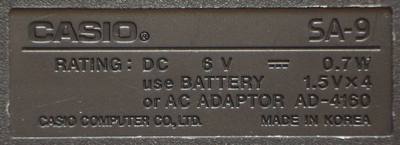 |
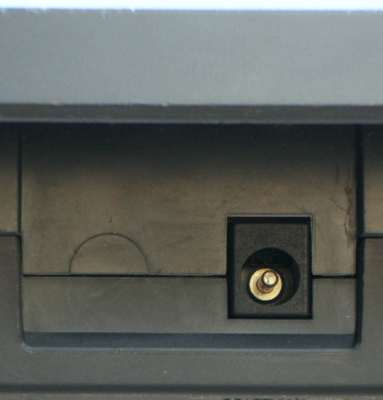 |
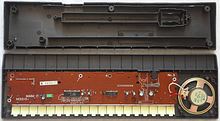 |
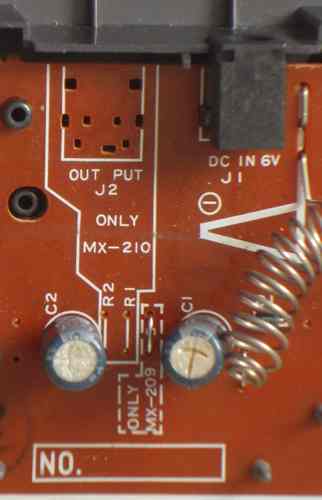 |
An even more crippled SA-1 variant with only 16 sounds (4 cipher buttons, same case) was released in white as Casio PK-1 and in black as PK-5. The PK-5 service manual falsely names the demo "Classical Medley" despite its CPU "M6387-03" also here has "American Patrol" (verified on Youtube). The 6 rightmost cipher buttons are omitted, but the PCB in service manual looks complete, so it should be easy to upgrade with all 100 sounds.

This keyboard of 1989 is a 4-note polyphonic midsize version of Casio SA-1 and belongs to the first SA-series instruments. A bit annoying is that volume can not be set lower than ambient volume. It was also released as Realistic Concertmate-450.
 |
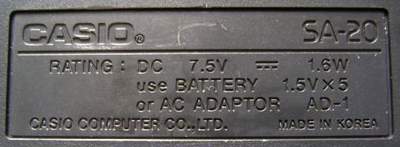 |
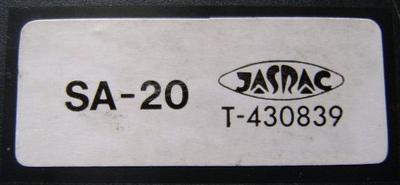 |
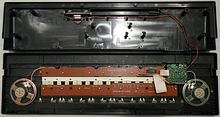 |
 |
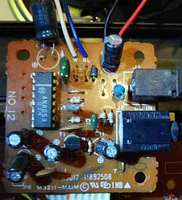 |
SA-20 variants with only 1 speaker were later released as Casio SA-10/
SA-11.
The direct successor of the first SA-series issue had exactly the same sound set, rhythm set and controls, but supported 5 different demo melodies and 5 additional drum pads. Its 4 note polyphonic midsize version was the Casio SA-21/ SA-25/ SA-38/ SA-39 (2 speakers). In India a variant with different demos (3 of them Hindi songs) came out as SA-41. The SA-21 hardware class was also used in the great PA-31 and the toy keyboard KA-20 (only 16 sounds by omitted buttons). The 2 note polyphonic mini key version was released in Casio SA-6, with only 25 sounds (omitted buttons) as SA-8/ SA-3 and even worse crippled (only 16 sounds, no tempo control) as SA-2. Also Casio PT-88 (polyphony 2 notes, mini keys) and PT-380 (polyphony 4 notes, midsize keys) employ this sound set; these have additional drumpads, ROM-Pack and key lighting feature (see Casio PT-80) but only 12 plain rhythms (resembling Casio ML-1). The same sound set (but different rhythms and user interface) has also Casio SA-65/ SA-67 (37 midsize keys, LCD display, polyphony 4 notes).
The same sound style but with the subject more on algorithmic synthesizer patterns instead of natural instruments are the Casio SA-5/ M-100 (polyphony 2 notes, mini keys) and Casio SA-35/ M-200 (polyphony 4 notes, midsize keys). These great keyboards are almost synthesizers because their 100 preset sounds are sorted into groups with "tone edit" variation button and the pattern speed and timbre can be drastically changed by the digital volume control.
In 2005 Casio released the SA-46/ SA-47 (32 midsize keys, small LCD) and SA-76/ SA-77/ SA-78 (44 midsize keys, larger LCD, 5 drumpads) with 100 preset sounds ("..6" and "..7" models differ in one organ sound), 50 rhythms (no accompaniment) and 10 demos. Later(?) the SA-76 was remade in pink/ black as SA-78. These are based on completely different hardware and so (although well made) have nothing common anymore with the original SA-series sound engine. Also the newer SA-80/ SA-81 sound different.
In 2013 at least retail webshops in India still regularly offered quantities of brand new classic SA-series keyboards. On the official Japanese Casio distributor Javys.com only few are marked "discontinued". I don't know if they are NOS or if Casio indeed still manufactures them. For a chip designed in 1989 it would make an impressive product lifespan, but IMO they still sound more spectacular and diversified than the zillion of boring Chinese toy tablehooters flooding the western market.
The only other cheap single chip keyboard family with similarly complex
algorithmic reverbing synth sounds is the Bontempi 666 sounds series
and its relatives (see GT 509).
Another interesting hardware family with cold and grainy digital lo-fi
sound is My Music Center, which
cheapness had lead to almost disappearance of toy-grade keyboards by name
brand companies.
| removal of these screws voids warranty... | ||
 |
||
|
|